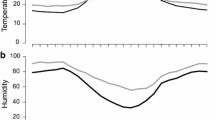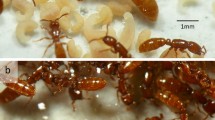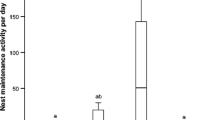Abstract
We investigated colony-level foraging activities of Diacamma sp., a queenless ponerine ant, in the field. Our aim was to elucidate the presence of any pattern in foraging activity in field colonies in relation to: (1) circadian rhythm, (2) physical environmental conditions such as extreme temperatures, (3) seasonality, and (4) short-term foraging efficiency (i.e. the success ratio in obtaining food per foraging trip). Colony-level foraging activity tended to be diurnal throughout the year, as more foraging trips were observed in the daytime. Although temperature had no linear effect on overall foraging activity, lower temperature precluded foraging at night. Overall, foraging was more frequent at times of day when foraging efficiency was high, but this relationship was weak and varied seasonally. Interestingly, we found that hourly foraging efficiency and hourly foraging activity were negatively correlated in autumn, the season when the average foraging efficiency peaked, whereas they were positively correlated in winter and spring.


Similar content being viewed by others
References
Adler F, Gordon DM (2003) Optimization, conflict, and non-overlapping foraging ranges in ants. Am Nat 162:529–542
Ashikin N, Hashim R (2015) Daily activity patterns of Platythyrea parallela in Peninsular Malaysia. Asian Myrmecol 7:145–154
Bernstein R (1979) Schedule of foraging activity in species of ants. J Anim Ecol 48:921–930
Bourke AFG (2011) Principles of social evolution. In: Harvey PH, May RM, Godfray CH, Dunne JA (eds) Oxford series in ecology and evolution. Oxford University Press, Oxford
Fuchikawa T, Okada Y, Miyatake T, Tsuji K (2014) Social dominance modifies behavioral rhythm in a queenless ant. Behav Ecol Sociobiol 68:1843–1850
Fujioka H, Abe MS, Fuchikawa T, Tsuji K, Shimada M, Okada Y (2017) Ant circadian activity associated with brood care type. Bio Lett. https://doi.org/10.1098/rsbl.2016.0743
Fujiwara-Tsujii N, Tokunaga K, Akino T, Tsuji K, Yamaoka R (2012) Identification of the tandem running pheromone in Diacamma sp. from Japan (Hymenoptera, Formicidae). Sociobiology 59:1281–1295
Fukumoto Y, Abe T (1983) Social organization of colony movement in the tropical ponerine ant, Diacamma rugosum (Le Guillou). J Ethol 1:101–108
Fukumoto Y, Abe T, Taki A (1989) A novel form of colony organization in the “queenless” ant Diacamma rugosum. Physiol Ecol Japan 26:55–61
Giannotti E, Machado VLL (1992) Notes on the foraging of two species of ponerine ants: food resources and daily hunting activities (Hymenoptera: Formicidae). Bioikos 6:7–17
Gordon DM (2010) Ant encounters: Interaction networks and colony behaviour. Princeton University Press, Princeton
Gordon DM, Dektar KN, Pinter-Wollman N (2013) Harvester ant colony variation in foraging activity and response to humidity. PLoS One. https://doi.org/10.1371/journal.pone.0063363
Hayashi Y, Yuki M, Sugawara K, Kikuchi T, Tsuji K (2012) Rhythmic behavior of social insects from single to multibody. Rob Auton Syst 60:714–721
Hayashi Y, Yuki M, Kikuchi T, Tsuji K, Sugawara K (2015) Effect of pair interactions on transition probabilities between inactive and active states—achieving collective behaviour via pair interactions in social insects. J Phys Soc Jpn. https://doi.org/10.7566/JPSJ.84.104801
Kaur R, Joseph J, Anoop K, Sumana A (2017) Characterization of recruitment through tandem running in an Indian queenless ant Diacamma indicum. R Soc Open Sci. https://doi.org/10.1098/rsos.160476
Kikuta N, Tsuji K (1999) Queen and worker policing in the monogynous and monandrous ant, Diacamma sp. Behav Ecol Sociobiol 46:180–189
Lima LD, Antonialli-Junior WF (2013) Foraging strategies of the ant Ectatomma vizottoi (Hymenoptera: Formicidae). Rev Bras Entomol 57:392–396
Medeiros FNS, Oliveira PS (2009) Seasonal-dependent foraging patterns: case study of a Neotropical forest-dwelling ant (Pachycondyla striata; Ponerinae), pp 81–95. In: Jarau S, Hrncir M (eds) Food exploitation by social insects: ecological, behavioral, and theoretical appoaches. Taylor & Francis, Boca Raton, p 348
Medeiros J, Araújo A, Araújo HPF, Queiroz JPC, Vasconcellos A (2012) Seasonal activity of Dinoponera quadriceps (Formicidae: Ponerinae) in the semi-arid caatinga of NE Brazil. Rev Bras Entomol 56:81–85
Medeiros J, Azevedo DLO, Santana MAD, Lopes TRP, Araújo A (2014) Foraging activity rhythms of Dinoponera quadriceps (Hymenoptera: Formicidae) in its natural environment. J Insect Sci. https://doi.org/10.1093/jisesa/ieu082
Nakata K (1995) Age polyethism, idiosyncrasy and behavioral flexibility in the queenless ponerine ant, Diacamma sp. J Ethol 13:113–123
Narenda A, Reid SF, Hemmi JM (2010) The twilight zone: ambient light levels trigger activity in primitive ants. Proc R Soc B 277:1531–1538
Okada Y, Sasaki K, Miyazaki S, Shimoji H, Tsuji K, Miura T (2015) Social dominance and reproductive differentiation mediated by the dopaminergic signaling in a queenless ant. J Exp Biol 218:1091–1098
Okada Y, Watanabe Y, Tin MMY, Tsuji K (2017) Social dominance alters nutrition-related gene expression immediately: transcriptomic evidence from a monomorphic queenless ant. Mol Ecol. https://doi.org/10.1111/mec.13989
Oster G, Wilson EO (1978) Caste and ecology in the social insects. Princeton University Press, Princeton
Peeters C, Crewe R (1987) Foraging and recruitment in ponerine ants: solitary hunting in the queenless Ophthalmopone berthoudi (Hymenoptera: Formicidae). Psyche 90:201–214
R Development Core Team (2013) R: a language and environment for statistical computing. R Foundation for Statistical Computing, Vienna. http://www.R-project.org. Accessed 25 Sep 2013
Raimundo RLG, Freitas AVL, Oliveira PS (2009) Seasonal patterns in activity rhythm and foraging ecology in the neotropical forest-dwelling ant, Odontomachus chelifer (Formicidae: Ponerinae). Ann Entomol Soc Am 102:1151–1157
Ravary F, Lecoutey E, Kaminski G, Châline N, Jaisson P (2007) Individual experience alone can generate lasting division of labor in ants. Curr Biol 17:1308–1312
Ríos-Casanova L, Castaño G, Farías-González V, Dávila P, Godínez-Alvarez H (2014) Activity patterns of the red harvester ant in a Mexican tropical desert. Sociobiology 61:133–135
Schafer RJ, Holmes S, Gordon DM (2006) Forager activation and food availability in harvester ants. Anim Behav 71:815–822
Schmidt CA, Shattuck O (2014) The higher classification of the ant subfamily Ponerinae (Hymenoptera: Formicidae), with a review of ponerine ecology and behavior. Zootaxa 3817:1–242
Shimoji H, Abe MS, Tsuji K, Masuda N (2014) Global network structure of dominance hierarchy of ant workers. J R Soc Interface. https://doi.org/10.1098/rsif.2014.0599
Shimoji H, Aonuma H, Miura T, Tsuji K, Sasaki K, Okada Y (2017) Queen contact and among-worker interactions dually suppress worker brain dopamine as a potential regulator of reproduction in an ant. Behav Ecol Sociobiol. https://doi.org/10.1007/s00265-016-2263-3
Stradling DJ (1978) Food and feeding habits of ants. In: Brian MV (ed) Production ecology of ants and termites. University Press, Cambridge, pp 81–106
Tsuji K, Kikuta N, Kikuchi T (2012) Determination of the cost of worker reproduction via diminished lifespan in the ant Diacamma sp. Evolution 66:1322–3311
Whitford WG (1999) Seasonal and diurnal activity patterns in ant communities in a vegetation transition region of southeastern New Mexico (Hymenoptera: Formicidae). Sociobiology 34:477–491
Acknowledgements
We thank Y. Okada and H. Fujioka for helpful advice.
Funding
This work was supported in part by KAKENHI grants (15H02652, 15H04425, 16K14865 and 17H01249).
Author information
Authors and Affiliations
Corresponding author
Ethics declarations
Conflict of interest
The authors declare that they have no conflict of interest.
Ethical approval
This article does not contain any studies with human participants performed by any of the authors. All applicable international, national and/or institutional guidelines for the care and use of animals were followed.
About this article
Cite this article
Win, A.T., Machida, Y., Miyamoto, Y. et al. Seasonal and temporal variations in colony-level foraging activity of a queenless ant, Diacamma sp., in Japan. J Ethol 36, 277–282 (2018). https://doi.org/10.1007/s10164-018-0558-8
Received:
Accepted:
Published:
Issue Date:
DOI: https://doi.org/10.1007/s10164-018-0558-8




